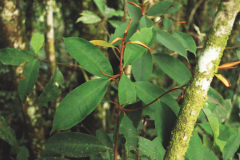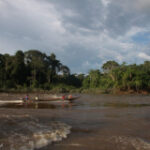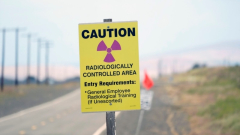- Researchers from Colombia’s Humboldt Institute are working with residents of the Claro River Basin in Antioquia department to conserve eight tree species in serious danger of going extinct.
- The species are endemic to Colombia: five are found only in the middle section of the Claro River Basin, while the others have been recorded in the neighboring departments of Santander and Caldas.
- Of the eight tree species being studied, Matisia serpicostata presents the most worrisome situation: only one specimen has been found in the area.
- Researchers and residents have established three tree nurseries to grow these species from seeds and cuttings, and eventually plant the seedlings in the wild.
In January 2020, Luis Carlos Galeano was traveling with his family through the Claro River Basin in Colombia’s mountainous Antioquia department when his wife, Viviana Aguirre, pointed out a tree by the side of the road that seemed strange to her. They examined the shape of its leaves, its 15-meter (50-foot) brown trunk, and its small fruit. It was the exceedingly rare Rhodostemonodaphne antioquensis, a laurel species known locally as chupo colorado.
“We recognized the tree and looked at it to see if we could find any seeds to plant. It’s the only tree [of its kind] I’ve seen in that area, and in fact, it’s the only one I’ve seen in all my life,” said Galeano, a farmer from the municipality of San Luis in eastern Antioquia. The family’s discovery wasn’t exactly good news.
In early 2022, the chupo colorado they’d identified was included in a scientific monitoring project organized by residents of San Luis and scientists from the Alexander von Humboldt Biological Resources Research Institute interested in these trees. In a later expedition by the institute, only one additional adult tree of the species was located, yielding a grand total of just two specimens in the area. This worried the researchers. R. antioquensis is characterized as endangered on the IUCN Red List, meaning its population, endemic to Antioquia, is on the brink of extinction.

This tree species isn’t the only one in jeopardy in Colombia. The Humboldt Institute has identified seven other endemic tree species that are at risk of extinction in the country. The situation is critical: three of these species are in a state of high vulnerability due to their shrinking populations. In addition to the chupo colorado, the researchers located only one adult specimen of Matisia serpicostata (critically endangered) and 12 Melicoccus antioquensis trees (critically endangered), most of them young. All these specimens are endemic to the department of Antioquia and were located in the middle section of the Claro River Basin.
The main threat to the trees is deforestation; their forest habitats are being lost to timber logging and to destruction and degradation for agricultural expansion. However, the communities who live in these areas and who have historically worked as farmers and loggers are now focused on conservation. Together, they’ve developed propagation methods and created three tree nurseries. One of them is run by the Galeano family.

“The nursery was born with the idea of giving back to nature what had been taken from it. We began to reproduce trees in danger of extinction. From there, we’ve been working and coming up with interesting things,” Galeano said of the tree cultivation methods they’ve learned and with which, through trial and error, they’ve achieved success.
The Humboldt Institute, with financing from the Franklinia Foundation, whose mission is to conserve threatened trees around the world, are promoting a new initiative in collaboration with the communities of the Claro River Basin to save the threatened species from extinction. As a team, they designed an action plan for the conservation of eight threatened tree species in the region.

Claro River ecosystem
According to the Humboldt Institute, Colombia has the world’s second-largest number of plants, with 26,900 native species recorded. Of this total, more than 6,000, or 24%, are endemic, meaning they’re found only in this South American country. However, some of the endemic tree species aren’t well known and are highly vulnerable to human activity and climate change impacts, as most have restricted distributions and some are even found in a single locality, according to the institute. It notes that, of the 860 endemic trees and bushes recorded in Colombia, 45% are threatened to some degree.

The Claro River Basin straddles the municipalities of Puerto Triunfo, San Luis, San Francisco and Sonsón. Jorge Bedoya, who coordinates the threatened tree conservation project at the Humboldt Institute, said the region’s geographic and geological characteristics favored the diverse evolution of plants, including several with restricted ranges and categorized as threatened.
“The Claro River is located in an ecosystem known as a karst zone,” Bedoya said. “Geologically speaking, its base, in the soil and subsoil, is a very particular rock because it’s like marble and creates very special conditions due to its pH, minerals and nutrients. There is a very strange microclimate there, with other conditions of humidity and temperature, which favors endemic flora.”

The eight threatened tree species in southeastern Antioquia — an area of 85,106 hectares (210,302 acres) along Colombia’s central mountain range that rises to an elevation of nearly 2,300 meters (about 7,500 feet) — were initially identified between 1980 and 2003 by Colombian researcher Álvaro Cogollo. He’s worked in the region for more than 40 years and has made many significant contributions to scientific research focused on conservation.
“In Colombia, the research done by Professor Cogollo, who is a plant expert, is well known,” said Bedoya, who’s collaborated on research with Cogollo. “He said that he had found species new to science and about which there was no good information or record. When the species were evaluated, we realized that they are classified as [threatened under] IUCN [criteria].”
Unique trees facing common threats
The eight tree species now being studied by the Humboldt Institute are:
- Matisia serpicostata, known locally as sapote de monte: Listed as critically endangered, with just one recorded specimen, standing about 12 m (40 ft) tall, with a brown stem and thick leaves.
- Caryodaphnopsis cogolloi, known locally as yumbé: Listed as endangered due to deforestation and overexploitation for timber. The species is named after Álvaro Cogollo.
- Cybianthus cogolloi, known locally as pipoly: The best-known of this group of threatened species, and listed as endangered. It grows to 12 m and is also named after Cogollo.
- Duguetia colombiana, known locally as guanabanito: Listed as vulnerable. It’s threatened by the expansion of cattle pastures, hydroelectric projects, and oil and gas exploration and exploitation. It’s named after its fruit that resembles a small guanabana or soursop.
- Melicoccus antioquensis, known locally as bush mamoncillo: Listed as critically endangered, with only 12 individuals found (two adults and 10 juveniles).
- Pseudoxandra sclerocarpa, known locally as garrapato or frísolo: Listed as vulnerable. Researchers have collected its seeds and begun propagating the plant, but it has a very slow germination and maturation period.
- Rhodostemonodaphne antioquensis, known locally as chupo colorado: Listed as endangered, and extremely scarce in the area, with only two adult individuals identified and no known seedlings. The main threats to the species are extraction of limestone rock and clay, as well as deforestation and cattle ranching.





